Annual report 2004 - Compagnia di San Paolo
Annual report 2004 - Compagnia di San Paolo
Annual report 2004 - Compagnia di San Paolo
You also want an ePaper? Increase the reach of your titles
YUMPU automatically turns print PDFs into web optimized ePapers that Google loves.
Sala Scarlatti’s organ, in the <strong>San</strong> Pietro a Majella Conservatory – Naples<br />
The Library of the “Conservatorio” of Music of <strong>San</strong> Pietro a Majella - Naples<br />
48<br />
The Real Collegio <strong>di</strong> Musica, or Collegio <strong>di</strong> Musica <strong>di</strong> <strong>San</strong><br />
Sebastiano, originated in 1806 from four secular<br />
institutions (the Orphanages of S.Onofrio a Capuana,<br />
S.Maria <strong>di</strong> Loreto, Pietà dei Turchini and of dei Poveri <strong>di</strong><br />
Gesù Cristo), which were established between the 16th<br />
and 17th centuries, originally de<strong>di</strong>cated to the sheltering<br />
and education of orphans and street children, and which<br />
later became real music schools, going on to form the new<br />
“Neapolitan school”, whose most illustrious exponent was<br />
Alessandro Scarlatti. The Real Collegio <strong>di</strong> Musica was<br />
transferred in 1826 into the present buil<strong>di</strong>ng, once the<br />
Convent of <strong>San</strong> Pietro a Majella, annex of the church of the<br />
same name of Celestini Fathers. In the 1800s the College<br />
of Music of <strong>San</strong> Sebastiano took the name Regio<br />
Conservatorio <strong>di</strong> Musica <strong>di</strong> <strong>San</strong> Pietro a Majella, affirming<br />
itself as one of the greatest Italian institutions in this field.<br />
The Conservatory possesses a very valuable archive and<br />
library (over 40,000 manuscripts and 400,000 printed<br />
e<strong>di</strong>tions): the documentation, which dates from 1500 to<br />
1800, has its origins in the collection of the volumes of the<br />
ancient Conservatory of the Pietà dei Turchini, enriched by<br />
various prestigious contribution, inclu<strong>di</strong>ng the collection<br />
of musical scores of Queen Maria Carolina and the<br />
collection of Giuseppe Sigismondo, to the music<br />
collection of the Royal House of Bourbon in 1900s.<br />
Declared a “scholastic library open to the public”, due to<br />
lack of funds it suffered progressive deterioration until the<br />
recent partial restoration and reorganisation works which<br />
ended in 2001 allowed for its reopening. In co-operation<br />
with the Superintendent, the Conservatory of <strong>San</strong> Pietro a<br />
Majella was in fact able to implement an integrated<br />
reorganisation project for the restoration and<br />
enhancement of its artistic and musical heritage. In that<br />
project other previously financed works converged: the<br />
restructuring of the buil<strong>di</strong>ng, under the auspices of the<br />
Superintendent for Architectural Heritage, the cabling of<br />
the institute and therefore of the Library for the connection<br />
with National Library System through the National Library<br />
network.<br />
The Conservatory intends to continue the general<br />
reorganisation and revitalisation project, setting it out in<br />
several fields. For the safety of the valuable manuscripts a<br />
five-year plan has been drawn up and which is underway<br />
and fully supported by the <strong>Compagnia</strong> <strong>di</strong> <strong>San</strong> <strong>Paolo</strong> with a<br />
grant of € 250,000. The works are concentrated on the<br />
most important materials: that is, 150 very precious<br />
manuscripts, inclu<strong>di</strong>ng autographed works and 16th<br />
century texts of the Sala Rossini, of approximately 40,000<br />
shots, which will produce three <strong>di</strong>fferent <strong>di</strong>gital formats<br />
accor<strong>di</strong>ng to the standard of the Digital Archive Project for<br />
Music by the Ministry for Cultural Heritage. Supporting<br />
the enhancement of such heritage through a sophisticated<br />
avant-garde project represents the typical example of the<br />
culture intervention of the <strong>Compagnia</strong> <strong>di</strong> <strong>San</strong> <strong>Paolo</strong>,<br />
aimed at the promotion of knowledge through growth of<br />
local skills.



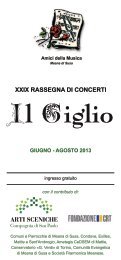
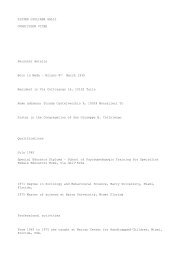
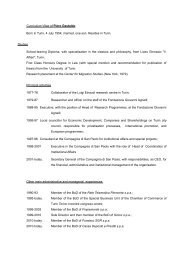
![ArchivioStorico 178 [PDF] - Compagnia di San Paolo](https://img.yumpu.com/47667361/1/185x260/archiviostorico-178-pdf-compagnia-di-san-paolo.jpg?quality=85)

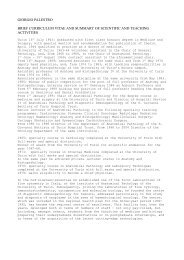
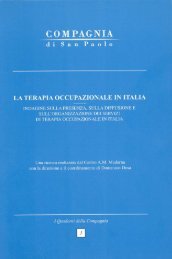
![brochure spazio 768 [PDF] - Compagnia di San Paolo](https://img.yumpu.com/36141511/1/190x255/brochure-spazio-768-pdf-compagnia-di-san-paolo.jpg?quality=85)
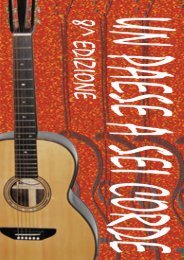
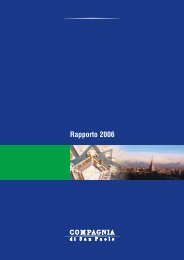
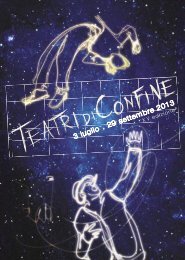

![Rapporto annuale 2008 [PDF] - Compagnia di San Paolo](https://img.yumpu.com/30320485/1/184x260/rapporto-annuale-2008-pdf-compagnia-di-san-paolo.jpg?quality=85)